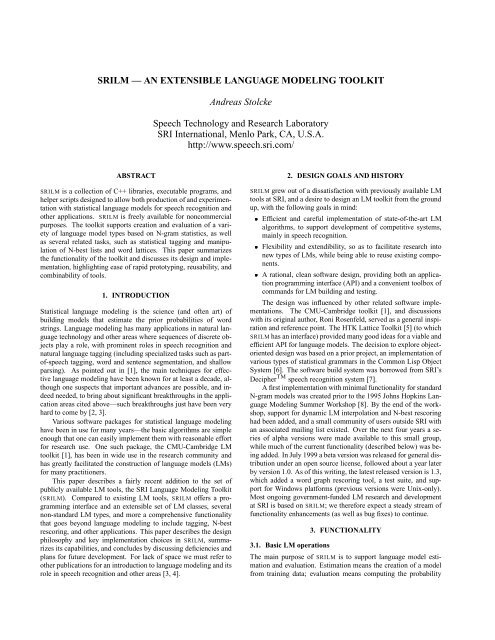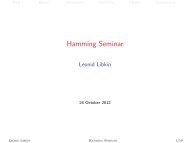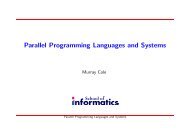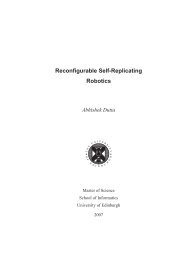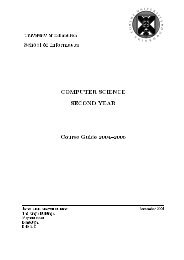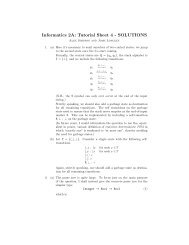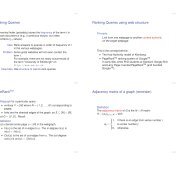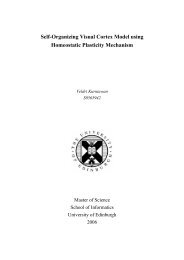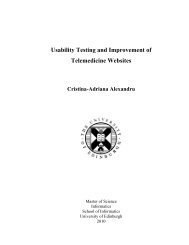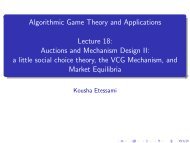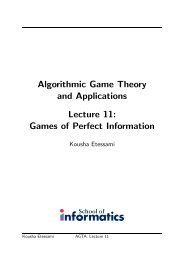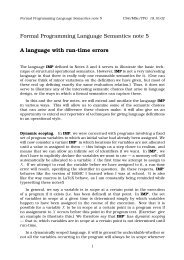SRILM â AN EXTENSIBLE LANGUAGE MODELING TOOLKIT ...
SRILM â AN EXTENSIBLE LANGUAGE MODELING TOOLKIT ...
SRILM â AN EXTENSIBLE LANGUAGE MODELING TOOLKIT ...
You also want an ePaper? Increase the reach of your titles
YUMPU automatically turns print PDFs into web optimized ePapers that Google loves.
<strong>SRILM</strong> — <strong>AN</strong> <strong>EXTENSIBLE</strong> L<strong>AN</strong>GUAGE <strong>MODELING</strong> <strong>TOOLKIT</strong><br />
Andreas Stolcke<br />
Speech Technology and Research Laboratory<br />
SRI International, Menlo Park, CA, U.S.A.<br />
http://www.speech.sri.com/<br />
ABSTRACT<br />
<strong>SRILM</strong> is a collection of C++ libraries, executable programs, and<br />
helper scripts designed to allow both production of and experimentation<br />
with statistical language models for speech recognition and<br />
other applications. <strong>SRILM</strong> is freely available for noncommercial<br />
purposes. The toolkit supports creation and evaluation of a variety<br />
of language model types based on N-gram statistics, as well<br />
as several related tasks, such as statistical tagging and manipulation<br />
of N-best lists and word lattices. This paper summarizes<br />
the functionality of the toolkit and discusses its design and implementation,<br />
highlighting ease of rapid prototyping, reusability, and<br />
combinability of tools.<br />
1. INTRODUCTION<br />
Statistical language modeling is the science (and often art) of<br />
building models that estimate the prior probabilities of word<br />
strings. Language modeling has many applications in natural language<br />
technology and other areas where sequences of discrete objects<br />
play a role, with prominent roles in speech recognition and<br />
natural language tagging (including specialized tasks such as partof-speech<br />
tagging, word and sentence segmentation, and shallow<br />
parsing). As pointed out in [1], the main techniques for effective<br />
language modeling have been known for at least a decade, although<br />
one suspects that important advances are possible, and indeed<br />
needed, to bring about significant breakthroughs in the application<br />
areas cited above—such breakthroughs just have been very<br />
hard to come by [2, 3].<br />
Various software packages for statistical language modeling<br />
have been in use for many years—the basic algorithms are simple<br />
enough that one can easily implement them with reasonable effort<br />
for research use. One such package, the CMU-Cambridge LM<br />
toolkit [1], has been in wide use in the research community and<br />
has greatly facilitated the construction of language models (LMs)<br />
for many practitioners.<br />
This paper describes a fairly recent addition to the set of<br />
publicly available LM tools, the SRI Language Modeling Toolkit<br />
(<strong>SRILM</strong>). Compared to existing LM tools, <strong>SRILM</strong> offers a programming<br />
interface and an extensible set of LM classes, several<br />
non-standard LM types, and more a comprehensive functionality<br />
that goes beyond language modeling to include tagging, N-best<br />
rescoring, and other applications. This paper describes the design<br />
philosophy and key implementation choices in <strong>SRILM</strong>, summarizes<br />
its capabilities, and concludes by discussing deficiencies and<br />
plans for future development. For lack of space we must refer to<br />
other publications for an introduction to language modeling and its<br />
role in speech recognition and other areas [3, 4].<br />
2. DESIGN GOALS <strong>AN</strong>D HISTORY<br />
<strong>SRILM</strong> grew out of a dissatisfaction with previously available LM<br />
tools at SRI, and a desire to design an LM toolkit from the ground<br />
up, with the following goals in mind:<br />
Efficient and careful implementation of state-of-the-art LM<br />
algorithms, to support development of competitive systems,<br />
mainly in speech recognition.<br />
Flexibility and extendibility, so as to facilitate research into<br />
new types of LMs, while being able to reuse existing components.<br />
A rational, clean software design, providing both an application<br />
programming interface (API) and a convenient toolbox of<br />
commands for LM building and testing.<br />
The design was influenced by other related software implementations.<br />
The CMU-Cambridge toolkit [1], and discussions<br />
with its original author, Roni Rosenfeld, served as a general inspiration<br />
and reference point. The HTK Lattice Toolkit [5] (to which<br />
<strong>SRILM</strong> has an interface) provided many good ideas for a viable and<br />
efficient API for language models. The decision to explore objectoriented<br />
design was based on a prior project, an implementation of<br />
various types of statistical grammars in the Common Lisp Object<br />
System [6]. The software build system was borrowed from SRI’s<br />
Decipher TM speech recognition system [7].<br />
A first implementation with minimal functionality for standard<br />
N-gram models was created prior to the 1995 Johns Hopkins Language<br />
Modeling Summer Workshop [8]. By the end of the workshop,<br />
support for dynamic LM interpolation and N-best rescoring<br />
had been added, and a small community of users outside SRI with<br />
an associated mailing list existed. Over the next four years a series<br />
of alpha versions were made available to this small group,<br />
while much of the current functionality (described below) was being<br />
added. In July 1999 a beta version was released for general distribution<br />
under an open source license, followed about a year later<br />
by version 1.0. As of this writing, the latest released version is 1.3,<br />
which added a word graph rescoring tool, a test suite, and support<br />
for Windows platforms (previous versions were Unix-only).<br />
Most ongoing government-funded LM research and development<br />
at SRI is based on <strong>SRILM</strong>; we therefore expect a steady stream of<br />
functionality enhancements (as well as bug fixes) to continue.<br />
3. FUNCTIONALITY<br />
3.1. Basic LM operations<br />
The main purpose of <strong>SRILM</strong> is to support language model estimation<br />
and evaluation. Estimation means the creation of a model<br />
from training data; evaluation means computing the probability
of a test corpus, conventionally expressed as the test set perplexity.<br />
Since most LMs in <strong>SRILM</strong> are based on N-gram statistics, the tools<br />
to accomplish these two purposes are named ngram-count and<br />
ngram, respectively. A standard LM (trigram with Good-Turing<br />
discounting and Katz backoff for smoothing) would be created by<br />
ngram-count -text TRAINDATA -lm LM<br />
The resulting LM may then be evaluated on a test corpus using<br />
ngram -lm LM -ppl TESTDATA -debug 2<br />
The ngram -debug option controls the level of detail of<br />
diagnostic output. A value of 2 means that probabilities are to<br />
be reported at the word level, including the order of N-gram used,<br />
in addition to the standard log probabilities and perplexities. Some<br />
additional statistics that also help gauge LM quality are the number<br />
of out-of-vocabulary (OOV) words and the “hit rates” of various<br />
levels of N-grams (in LMs based on N-grams) [1]; these are either<br />
computed by ngram itself or (as in the case of hit rates) tallied by<br />
auxiliary scripts that analyze the ngram output.<br />
<strong>SRILM</strong> by itself performs no text conditioning, and treats everything<br />
between whitespace as a word. Normalization and tokenization<br />
of text are highly corpus-dependent, and are typically<br />
accomplished with filters that preprocess the data.<br />
3.2. Bells and whistles<br />
The programs ngram-count and ngram have a rather large<br />
number of options to control the many parameters of LM estimation<br />
and testing. The most important parameters for LM training<br />
are<br />
the order of N-grams to use (e.g., unigram, bigram). There is<br />
no built-in limit on the length of N-grams.<br />
the type of discounting algorithm to use. Currently supported<br />
methods include Good-Turing, absolute, Witten-Bell,<br />
and modified Kneser-Ney [9]. Each of these discounting methods<br />
requires its own set of parameters, as well as a choice of<br />
whether higher- and lower-order estimates are to be combined<br />
via backoff or interpolation.<br />
an optional predefined vocabulary to limit or augment the set<br />
of words from the training data.<br />
whether unknown words are to be discarded or treated as a<br />
special “unknown word” token.<br />
whether to collapse case distinctions in the input text.<br />
Beyond LM estimation, ngram-count performs useful N-gram<br />
count manipulations, such as generating counts from text, summing<br />
count files, and recomputing lower-order counts from higherorder<br />
counts. ngram-count handles integer or fractional counts,<br />
although only a subset of the smoothing algorithms supports the<br />
latter (generally speaking, those that rely on counts-of-counts<br />
statistics do not).<br />
The main parameters controlling LM evaluation are the order<br />
of N-gram to use (which can be lower than what the LM includes,<br />
so that a 4-gram model may conveniently be used also as a bigram<br />
or trigram model), and the variant of N-gram model to use—for<br />
example, a word-based, class-based, or interpolated N-gram, as<br />
well as any additional parameters associated with that type of LM.<br />
The types of models supported are described further in Section 3.3.<br />
Beyond LM evaluation, ngram is really a tool to manipulate<br />
LMs in a variety of ways. Besides computing test set log probabilities<br />
from text or counts, it can<br />
renormalize a model (recomputing backoff weights)<br />
approximate a class-based or interpolated N-gram with a standard<br />
word-based backoff LM<br />
prune N-gram parameters, using an entropy criterion [10]<br />
prepare LMs for conversion to finite-state graphs by removing<br />
N-grams that would be superseded by backoffs<br />
generate random sentences from the distribution embodied by<br />
the LM.<br />
The ability to approximate class-based and interpolated N-<br />
gram LMs by a single word N-gram model deserves some discussion.<br />
Both of these operations are useful in situations where<br />
other software (e.g., a speech recognizer) supports only standard<br />
N-grams. Class N-grams are approximated by expanding class labels<br />
into their members (which can contain multiword strings) and<br />
then computing the marginal probabilities of word N-gram strings.<br />
This operation increases the number of N-grams combinatorially,<br />
and is therefore feasible only for relatively small models.<br />
An interpolated backoff model is obtained by taking the union<br />
of N-grams of the input models, assigning each N-gram the<br />
weighted average of the probabilities from those models (in some<br />
of the models this probability might be computed by backoff), and<br />
then renormalizing the new model. We found that such interpolated<br />
backoff models consistently give slightly lower perplexities<br />
than the corresponding standard word-level interpolated models.<br />
The reason could be that the backoff distributions are themselves<br />
obtained by interpolation, unlike in standard interpolation, where<br />
each component model backs off individually.<br />
3.3. Language model types<br />
Besides the standard word-based N-gram backoff models, <strong>SRILM</strong><br />
implements several other LM types, most of them based on N-<br />
grams as basic building blocks.<br />
Class-based models — N-grams over word classes are an effective<br />
way to increase the robustness of LMs and to incorporate<br />
domain knowledge, e.g., by defining word classes reflecting the<br />
task semantics. <strong>SRILM</strong> allows class members to be multiword<br />
strings (e.g., “san francisco” can be a member of class “CITY-<br />
NAME”). This, and the fact that words can belong to more than<br />
one class, requires the use of dynamic programming to evaluate<br />
a class N-gram. Word classes may be defined manually or by a<br />
separate program, ngram-class, which induces classes from<br />
bigram statistics using the Brown algorithm [11].<br />
Cache models — This well-known LM technique assigns<br />
nonzero probability to recent words, thus modeling the tendency<br />
of words to reoccur over short spans [12]. They are usually interpolated<br />
with a standard model to obtain an adaptive LM.<br />
Disfluency and hidden event language models — Hidden event<br />
LMs incorporate special words that appear in the model’s N-<br />
grams, but are not overt in the observed word stream. Instead, they<br />
correspond to the states of a hidden Markov model, and can be<br />
used to model linguistic events such as unmarked sentence boundaries.<br />
Optionally, these events can be associated with nonlexical<br />
likelihoods to condition the LM on other knowledge sources (e.g.,<br />
prosody) [13]. A special type of hidden event LM can model<br />
speech disfluencies by allowing the hidden events to modify the<br />
word history; for example, a word deletion event would erase one<br />
or more words to model a false start [14].<br />
Skip language models — In this LM, words in the history are<br />
probabilistically skipped, allowing more distant words to take their
places. The skipping probabilities associated with each word are<br />
estimated using expectation maximization.<br />
HMMs of N-grams — This LM consists of a hidden Markov<br />
model (HMM) where each state is associated with its own N-gram<br />
distribution. The model generates from a certain state until the local<br />
N-gram issues an end-of-sentence, at which point it transitions<br />
probabilistically to a neighboring state. HMMs of N-grams provide<br />
a general framework that can encode a variety of LM types<br />
proposed in the literature, such as sentence-level mixtures [15] and<br />
pivot LMs [16].<br />
Dynamically interpolated LMs — Two or more LMs can be<br />
interpolated linearly at the word level such that the interpolation<br />
weights reflect the likelihoods of the models given the recent N-<br />
gram history [8]. With a null history, we obtain the usual static<br />
LM interpolation approach that is often used to combine different<br />
sources of training material into a single model.<br />
3.4. Other applications of language models<br />
Over the years <strong>SRILM</strong> has evolved to include tools that go beyond<br />
simple LM construction and evaluation, covering mainly LM applications<br />
arising in speech recognition.<br />
disambig — an HMM-based tagger that uses N-gram LMs of<br />
arbitrary order to model the prior on tag sequences.<br />
hidden-ngram — a word boundary tagger, based on hidden<br />
event N-gram models.<br />
segment-nbest — a rescoring tool that applies a language<br />
model over a sequence of adjoining N-best lists, thereby overcoming<br />
sentence segmentation mismatch [17].<br />
lattice-tool — a tool to rescore and expand word lattices.<br />
nbest-lattice — a tool to perform word error minimization<br />
on N-best lists [18] or construct confusion networks<br />
(“sausages”) [19]. Together with a helper script, this tool also<br />
implements a word posterior-based N-best generalization of<br />
the ROVER algorithm [20, 21].<br />
nbest-scripts — a collection of wrapper scripts that manipulate<br />
and rescore N-best lists.<br />
pfsg-scripts — for converting LMs to word graphs.<br />
nbest-optimize — optimizes log linear score combination<br />
for word posterior-based (“sausage”) decoding.<br />
4. DESIGN <strong>AN</strong>D IMPLEMENTATION<br />
<strong>SRILM</strong> is designed and implemented in three layers.<br />
1. At the core are libraries comprising about 50 C++ classes<br />
for language models and miscellaneous objects (such as vocabulary<br />
symbol tables, N-best lists, word graphs, DP trellises),<br />
which in turn make use of a library of efficient container<br />
classes (e.g., arrays, hash tables).<br />
2. The 14 main executable tools such as ngram-count,<br />
ngram, and taggers, are written in C++ on top of the API<br />
provided by the libraries.<br />
3. Numerous helper and wrapper scripts perform miscellaneous<br />
tasks that are more conveniently implemented in the gawk and<br />
Bourne shell scripting languages.<br />
We summarize the characteristics of each implementation layer.<br />
4.1. Class libraries<br />
C++ class libraries implement the API of <strong>SRILM</strong>. Object-oriented<br />
programming turns out to be an excellent match for LM implementation,<br />
for several reasons. A class hierarchy naturally reflects the<br />
specialization relation between different LM types (e.g., a class N-<br />
gram is a special case of an N-gram, which is a special case of an<br />
LM). Inheritance allows new LM variants to be derived from existing<br />
ones with minimal effort. A new LM class minimally needs<br />
to define only a wordProb function, the method used to compute<br />
conditional probabilities given a word and its history. 1 Most LM<br />
functions are defined generically, and need not be reimplemented<br />
for a new derived LM class. For example, sentenceProb is<br />
defined in terms of wordProb and typically inherited from the<br />
generic LM class; however, a given LM can define its own version<br />
of sentenceProb, for efficiency or to change the standard<br />
behavior.<br />
Hash tables, arrays, tries, and other basic data structures have<br />
been implemented from scratch, for speed and compactness under<br />
the types of uses associated with LM data structures. 2 Templatized<br />
data structures and functions are very useful beyond the low-level<br />
containers; N-gram statistics and estimation functions, for example,<br />
are templatized to support both integer and fractional counts.<br />
4.2. Executable tools<br />
The executable tools are designed to be both self-contained and<br />
combinable in useful ways. Thus, as shown earlier, a standard LM<br />
can be built from a text file in a single invocation. More complex<br />
manipulations are possible by chaining together tools, using the<br />
Unix standard input/output and “pipe” mechanism. Thus, a classbased<br />
N-gram model can be trained, pruned, expanded into a word<br />
trigram model, and interpolated with another model using the following<br />
pipeline (some options have been omitted to save space):<br />
replace-words-with-classes TRAINDATA | \<br />
ngram-count -text - -lm - | \<br />
ngram -lm - -prune 1e-5 -write-lm - | \<br />
ngram -lm - -expand-classes 3 -write-lm - | \<br />
ngram -lm - -mix-lm LM2 -write-lm MIXLM<br />
4.3. Helpers and wrappers<br />
Miscellaneous other tools are implemented in gawk and shell<br />
scripts, either because they involve simple text manipulations<br />
that are more conveniently done this way (such as<br />
replace-words-with-classes in the example above), or<br />
because they only require a wrapper that combines the basic tools.<br />
An example of the latter is change-lm-vocab, ascriptthat<br />
modifies the vocabulary of an existing N-gram LM. The script<br />
eliminates N-grams that have become OOV (using the textual LM<br />
format) and then lets ngram fill in new unigrams and renormalize<br />
the backoff weights. Other scripts parse the diagnostic output of<br />
the tools, such as compute-best-mix, which computes optimal<br />
interpolation weights from ngram -ppl output.<br />
1 Often a read function is also needed, but can be borrowed from an<br />
existing class if the same external representation is used, as is frequently<br />
the case with N-gram based models.<br />
2 We considered switching to the Standard Template Library (STL) for<br />
containers, but found that this would incur a significant loss of both speed<br />
and compactness.
4.4. File formats<br />
<strong>SRILM</strong> uses standard file formats where possible—in particular,<br />
the ARPA format for N-gram backoff LMs. Word graphs use SRI’s<br />
probabilistic finite-state grammar (PFSG) format, which can be<br />
converted to and from that used by AT&T’s finite state machine<br />
toolkit [22]. Where new file formats were needed we chose easyto-parse<br />
textual representations. All the main tools can read and<br />
write compressed files, as large amounts of data and models are<br />
often associated with LM work. We avoided binary file formats<br />
because of their lack of portability and flexibility, and prefer to use<br />
compressed textual formats instead.<br />
5. SHORTCOMINGS <strong>AN</strong>D FUTURE DEVELOPMENTS<br />
Many well-established LM techniques are not implemented in<br />
<strong>SRILM</strong>, such as deleted interpolation or maximum entropy modeling,<br />
mainly because these have not proven essential in our work so<br />
far. One candidate for future addition is a more flexible class-based<br />
model, since refinements of class-based LMs seem to provide an<br />
effective and efficient way to incorporate grammatical information<br />
into the LM [23]. The low-level implementation of data structures<br />
is currently biased toward speed and convenience rather than<br />
memory usage; it might be worthwhile to reevaluate this choice<br />
to accommodate ever-larger training corpora. <strong>SRILM</strong> currently assumes<br />
single-byte character encoding and uses only whitespace for<br />
tokenization; it would be desirable to include support for multibyte<br />
character sets and SGML-tagged formats at some point. Ultimately,<br />
however, development of the toolkit will continue to be<br />
driven by research needs, and is therefore hard to predict.<br />
Availability. <strong>SRILM</strong> is freely available for noncommercial<br />
users under an Open Source Community License, designed<br />
to ensure that enhancements by others find their way back<br />
into the user community. Licensing for commercial purposes<br />
is also available. Documentation and software are online at<br />
http://www.speech.sri.com/projects/srilm/.<br />
6. ACKNOWLEDGMENTS<br />
Fuliang Weng wrote the initial version of the lattice rescoring tool in<br />
<strong>SRILM</strong>; Dimitra Vergyri developed the score combination optimizer based<br />
on simplex search; Anand Venkataraman contributed N-best decoding<br />
and other enhancements to the statistical tagging tools. Development of<br />
<strong>SRILM</strong> has benefited greatly from its use and constructive criticism by<br />
many colleagues at SRI, the Johns Hopkins summer workshops, and the<br />
larger research community. Barbara Peskin helped improve this paper<br />
with valuable suggestions. The work described here was in part supported<br />
by DARPA under contract N66001-97-C-8544 and by NSF-STIMULATE<br />
grant IRI-9619921. The views herein are those of the author and do not<br />
reflect the policies of the funding agencies.<br />
7. REFERENCES<br />
[1] P. Clarkson and R. Rosenfeld, “Statistical language modeling using<br />
the CMU-Cambridge toolkit”, in G. Kokkinakis, N. Fakotakis, and<br />
E. Dermatas, editors, Proc. EUROSPEECH, vol. 1, pp. 2707–2710,<br />
Rhodes, Greece, Sep. 1997.<br />
[2] F. Jelinek, “Up from trigrams! The struggle for improved language<br />
models”, in Proc. EUROSPEECH, pp. 1037–1040, Genova, Italy,<br />
Sep. 1991.<br />
[3] R. Rosenfeld, “Two decades of statistical language modeling: Where<br />
do we go from here?”, Proceedings of the IEEE, vol. 88, 2000.<br />
[4] D. Jurafsky and J. H. Martin, Speech and Language Processing: An<br />
Introduction to Natural Language Processing, Computational Linguistics,<br />
and Speech Recognition, Prentice-Hall, Upper Saddle River,<br />
NJ, 2000.<br />
[5] J. J. Odell, Lattice and Language Model Toolkit Reference Manual,<br />
Entropic Cambridge Research Laboratories, Inc., 1995.<br />
[6] A. Stolcke, Bayesian Learning of Probabilistic Language Models,<br />
PhD thesis, University of California, Berkeley, CA, July 1994.<br />
[7] H. Murveit, J. Butzberger, V. Digalakis, and M. Weintraub, “Largevocabulary<br />
dictation using SRI’s DECIPHER speech recognition system:<br />
Progressive search techniques”, in Proc. ICASSP, vol. II, pp.<br />
319–322, Minneapolis, Apr. 1993.<br />
[8] M. Weintraub, Y. Aksu, S. Dharanipragada, S. Khudanpur, H. Ney,<br />
J. Prange, A. Stolcke, F. Jelinek, and E. Shriberg, “LM95 Project<br />
Report: Fast training and portability”, Research Note 1, Center for<br />
Language and Speech Processing, Johns Hopkins University, Baltimore,<br />
Feb. 1996.<br />
[9] S. F. Chen and J. Goodman, “An empirical study of smoothing techniques<br />
for language modeling”, Technical Report TR-10-98, Computer<br />
Science Group, Harvard University, Aug. 1998.<br />
[10] A. Stolcke, “Entropy-based pruning of backoff language models”,<br />
in Proceedings DARPA Broadcast News Transcription and Understanding<br />
Workshop, pp. 270–274, Lansdowne, VA, Feb. 1998. Morgan<br />
Kaufmann.<br />
[11] P. F. Brown, V. J. Della Pietra, P. V. deSouza, J. C. Lai, and R. L.<br />
Mercer, “Class-based n-gram models of natural language”, Computational<br />
Linguistics, vol. 18, pp. 467–479, 1992.<br />
[12] R. Kuhn and R. de Mori, “A cache-base natural language model for<br />
speech recognition”, IEEE PAMI, vol. 12, pp. 570–583, June 1990.<br />
[13] A. Stolcke, E. Shriberg, D. Hakkani-Tür, and G. Tür, “Modeling<br />
the prosody of hidden events for improved word recognition”, in<br />
Proc. EUROSPEECH, vol. 1, pp. 307–310, Budapest, Sep. 1999.<br />
[14] A. Stolcke and E. Shriberg, “Statistical language modeling for speech<br />
disfluencies”, in Proc. ICASSP, vol. 1, pp. 405–408, Atlanta, May<br />
1996.<br />
[15] R. Iyer, M. Ostendorf, and J. R. Rohlicek, “Language modeling with<br />
sentence-level mixtures”, in Proc. ARPA HLT Workshop, pp. 82–86,<br />
Plainsboro, NJ, Mar. 1994.<br />
[16] K. W. Ma, G. Zavaliagkos, and M. Meteer, “Sub-sentence discourse<br />
models for conversational speech recognition”, in Proc. ICASSP,<br />
vol. II, pp. 693–696, Seattle, WA, May 1998.<br />
[17] A. Stolcke, “Modeling linguistic segment and turn boundaries for N-<br />
best rescoring of spontaneous speech”, in G. Kokkinakis, N. Fakotakis,<br />
and E. Dermatas, editors, Proc. EUROSPEECH, vol. 5, pp.<br />
2779–2782, Rhodes, Greece, Sep. 1997.<br />
[18] A. Stolcke, Y. Konig, and M. Weintraub, “Explicit word error minimization<br />
in N-best list rescoring”, in G. Kokkinakis, N. Fakotakis,<br />
and E. Dermatas, editors, Proc. EUROSPEECH, vol. 1, pp. 163–166,<br />
Rhodes, Greece, Sep. 1997.<br />
[19] L. Mangu, E. Brill, and A. Stolcke, “Finding consensus in speech<br />
recognition: Word error minimization and other applications of confusion<br />
networks”, Computer Speech and Language, vol. 14, pp. 373–<br />
400, Oct. 2000.<br />
[20] J. G. Fiscus, “A post-processing system to yield reduced word error<br />
rates: Recognizer output voting error reduction (ROVER)”, in<br />
Proceedings IEEE Automatic Speech Recognition and Understanding<br />
Workshop, pp. 347–352, Santa Barbara, CA, 1997.<br />
[21] A. Stolcke, H. Bratt, J. Butzberger, H. Franco, V. R. Rao Gadde,<br />
M. Plauché, C. Richey, E. Shriberg, K. Sönmez, F. Weng, and<br />
J. Zheng, “The SRI March 2000 Hub-5 conversational speech transcription<br />
system”, in Proceedings NIST Speech Transcription Workshop,<br />
College Park, MD, May 2000.<br />
[22] M. Mohri, F. Pereira, and M. Riley, “FSM Library—<br />
general-purpose finite-state machine software tools, version 3.6”,<br />
http://www.research.att.com/sw/tools/fsm/, 1998.<br />
[23] W. Wang, Y. Liu, and M. P. Harper, “Rescoring effectiveness of<br />
language models using different levels of knowledge and their integration”,<br />
in Proc. ICASSP, Orlando, FL, May 2002.


